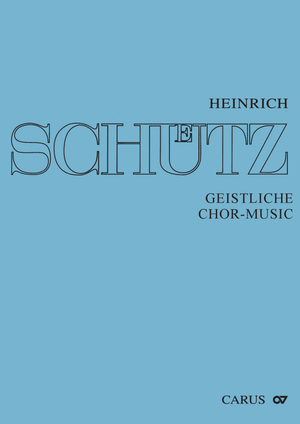
Opera varia I. Works with 1–7 parts (Complete edition, vol. 19)
Stuttgart Schütz Edition
Volume 19 of the Schütz Complete Edition brings together 21 very different compositions from various phases of Schütz’s compositional output. The spectrum ranges from a short, two-part sacred concerto to a six-part cyclical psalm setting and large-scale polychoral concerto, from well-known works such as the “Osterdialog” to a completely unknown madrigalian composition, full of emotion, to a simple chorale setting.
A particular challenge was posed by the ten works or versions of works which survive incomplete. Two of these, the Christmas concerto “Ach Herr, du Schöpfer aller Ding” SWV 450a and “Ein Kind ist uns geboren” SWV 497, appear here for the first time in print. With both of these it turned out that it was possible to reconstruct the missing parts fully from available material. For the “Ultima Verba Psalmi 23”, “Gutes und Barmherzigkeit” SWV 95 and the two “Nunc dimittis: Herr, nun lässest du deinen Diener” SWV 432 and 433, the editor’s reconstructions are presented, and likewise with the chorale movement “In dich hab ich gehoffet, Herr” SWV 446. The impressive Easter dialog “Weib, was weinest du” SWV 443 is one of the works which survives incomplete. In order to give an impression of how the whole work might actually have sounded in the complete form as planned by Schütz, the Appendix to the volume contains a reconstruction of the four-part vocal setting of the missing final chorus, based on the surviving figured bass. The magnificent “Gesang der drei Männer im feurigen Ofen” (Song of the three men in the burning fiery furnace) SWV 448 from the book of the prophet Daniel, the original source of which is lost, is critically discussed and published with various possibilities for scoring.
Acheter
Informations complémentaires sur l'œuvre
Sommaire
-
Compositeur
Heinrich Schütz
| 1585-1672Heinrich Schütz is regarded as the first German musician of European stature. As a choirboy from 1599 at the court of Landgrave Moritz of Hessen-Kassel, he received a thorough education. In 1608 he began a law degree in Marburg, but broke this off in 1609 in order, with the support of the Landgrave, to study composition with Giovanni Gabrieli, organist at St Mark’s in Venice. In 1613 Schütz returned to Kassel, but two years later was enticed away by Elector Johann Georg I of Saxony to the Dresden court as “Organist und Director der Musica”, where he held the position of Hofkapellmeister (court Kapellmeister) from 1617 until his death. Schütz’s great cycles of vocal works marked the high point of his reputation in Germany and northern Europe. But these represent only part of Schütz’s output; individual works are represented in printed collections with works by other composers, others only survive in manuscript, and much has been lost. The Stuttgart Schütz Edition makes available Schütz’s complete oeuvre, and all works are also published in practical Urtext editions. Plus d'information sur la personne
-
Éditeur
Helmut Lauterwasser
Questions fréquentes sur l'œuvre
 Il n'y a pas encore de questions et réponses concernant cette œuvre ou vous n'avez pas trouvé la réponse à votre question sur l'œuvre ? Cliquez ici et envoyez votre question spécifique à notre service clients.
Il n'y a pas encore de questions et réponses concernant cette œuvre ou vous n'avez pas trouvé la réponse à votre question sur l'œuvre ? Cliquez ici et envoyez votre question spécifique à notre service clients.






